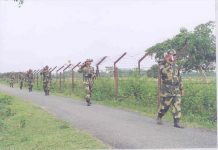Within days of the killing of four Army jawans inside Bathinda military station in Punjab, the police held one of their colleagues for the fratricide, reportedly committed in retaliation to the repeated “humiliation and harassment’’ meted out to him by the quartet, writes Rajesh Moudgil
By April 12 forenoon, the news about the dastardly killing of four Army jawans while they were asleep in their barrack inside the Bathinda military station in Punjab – that is located near Pakistan border – had spread not only across the country, but also around the world.
The deceased soldiers (all Gunners), from an Artillery regiment, were Sagar Banne, Kamalesh R, Yogesh Kumar J and Santosh M Nagral.
Home to the 10 Corps, the Bathinda military station is considered to be a vital Indian Army base for defending Punjab and neighbouring Rajasthan borders from Pakistan. Spread in a vast area including forest cover, it has a number of units from different divisions including infantry, armoured, aviation, artillery, signals and engineers.
The first information report (FIR) lodged at the Bathinda Cantonment police station by the military station’s Major Ashutosh Shukla, said that he was informed by Desai Mohan, a jawan on sentry (guard) duty about the firing incident around 4.30 am on April 12, who saw two persons wearing “kurta-pyjamas’’, one of whom carried an Insas (Indian small arms system) rifle and another an axe, running towards forests of the Army station before melting into the darkness after the incident.
According to the initial probe, the police and the Army investigators ruled out any terror attack though there were still no coherent answers available about the assailants and their motive behind the brutal killings.
Missing Army Insas Rifle
Pertinently, in a major disclosure, it was also learnt that the shocking killing incident was on the back of an Insas rifle along with 28 rounds going missing on April 10 from inside the military station.
Significantly enough, it was also subsequently learnt that the said rifle was used for killing the four soldiers and that the same had been recovered on April 12 along with the magazine of which forensic analysis was in progress.
The questions then were asked as to why the probe into the case of missing weapon and ammunition took time – untill April 12 when the four jawans had been killed.
Meanwhile, even though the Army had pressed into service hexacopters and drones in the entire area, the police and army investigators scanned all the CCTV footage of the Army station for clues, though could not get any solid leads.
Holes in eyewitess’ version
It was after getting extensive checks done on the CCTV footages of all possible entry and exit points as well as grilling of various guards on duty – especially around the spot and at around the time of the crime -, the investigators had begun on April 13 zeroing in on the account of the so-called eyewitness, Desai Mohan, only to find some holes in his version given a day before.
The police had then said that the eye-witness’ version raised suspicion as no sharp-edged weapon injuries were found in the soldiers’ bodies in the post mortem and there were only injuries from gunshots. Also, except for the eye-witness, no other person on duty in the entire area had spotted the movement of two men in civvies.
Moreover, it appeared to be a targeted killing, as there would have been indiscriminate firing in case of a terror attack.
The headway
Having exhausted different theories doing the rounds, the Punjab police finally approached Army authorities on April 16 asking them to make available about 10 Army personnel, including Desai Mohan and another soldier, also gunner Naga Suresh, so that they could be quizzed or their statements recorded.
Subsequently, Desai Mohan was apparently arrested late April 16 night itself for fratricide in retaliation of repeated harassment and humiliation meted out to him by the four. He had also reportedly confessed to having stolen the Insas rifle and its ammunition on April 10, police said.
According to Bathinda senior superintendent of police (SSP) Gulneet Khurana and Col Animesh Sharan from the Bathinda military station, the accused army jawan, Gunner Desai Mohan, had killed the four soldiers in a premeditated plan as per which, he first stole an Insas rifle and bullets on April 10, hid them for two days and subsequently killed them on April 12.
The police also said that the accused who was on guard duty at the officers’ mess on April 12, had gone to the barrack – where the four soldiers were sleeping in different rooms in the barrack – twice around 3 am to ensure they were asleep, before killing them.
They further said that the accused had confessed his crime which he held was in retaliation to the “repeated harassment and humiliation” caused to him by his four colleagues. On the question about the nature of the harassment or whether it was physical or sexual, SSP Khurana categorically said that it was a matter of further probe into the case.
Col Sharan said that when the Insas rifle, its 20 cartridges and another eight bullets of a light machine gun (LMG) were reported to be missing on April 10, the military base was put on high alert and now the matter was further investigated under court of inquiry (CoI), though the rifle used in the crime as well as six cartridges of the LMG had been recovered from a sewage pit dumped by the accused in the compound. The police had already recovered the 19 empty shells of the Insas rifle from the spot of the crime on April 12 only.
Now, remedial steps under focus
Meanwhile, the dastardly killings at Bathinda military station has once again raised the questions pertaining to the lack of connect between the senior leaders and the jawans behind the fratricide incidents that continue to take place in the security forces.
According to media reports, as many as 18 incidents of fratricide are reported to have taken place in the Indian Army and two in the Indian Air Force (IAF) between 2014 and March 21, 2021.
The media reports say that while two Army personnel were killed and as many injured in a fratricidal incident inside an Army camp in Jammu and Kashmir in 2022, fratricidal and suicide cases were much higher in the Central Armed Police Forces (CAPF).
If the reports are to be believed, 29 personnel of the CAPF were killed by their colleagues in the past five years between 2018 and 2022, according to the data presented by Union Minister of State for Home affairs Nityanand Rai in the Lok Sabha on March 28, 2023.
Media reports also raised questions if the military establishments, especially the Bathinda station, had ensured an effective grievance redressal system, the accused could have brought up the “harassment and humiliation’’ issue with his superiors. Lack of such a platform may have prompted the soldier to take the extreme step, said the reports.
Underlining the urgent need to ensure harassment-free life inside military bases, the reports also underlined the extreme working conditions and the mental stress which act as a trigger for such incidents.













